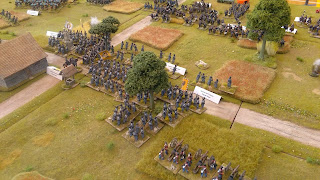The SELWG annual
Wargaming Show has come and gone and it is the only show that I have been able
to get to this year.
Set in the lovely grounds of
the Crystal Palace Park in the sports centre the autumn sun was shining as I
arrived just before 10:45am. After paying my entry fee and picking up a
programme I set off for the trade stands first as I always do at this show.
Although I did take some war
funds with me I knew that there would not be any figures for me to buy as I
have a back log of painting to do before I can see what figures I need,
although saying that I am still waiting for HaT to produce the Elite in
Greatcoats sets.
The top floor looked busier
than past shows and after a look at the the first lot of traders I came to the Harfields stand. I love these guys
as they always seem to have what I have wanted in the past. Looking through their two big trays of plastic
soldiers I came across a packet of Italeri French wagons.
There were two wagons in this
packet one blue and one in silver with the same coloured horses to match. (I
hope to write a piece on transport on this blog soon) When I returned home to
take a proper look I found that most of the pieces were there and I had four
extra horses. For two and a half quid it was worth it.
I did try to get to the bring
and buy stand but as always it was very busy and I had to come later on in the
day to see what was on offer. Here I brought a hard back book from Philip J
Haythornthwaite called “Napoleon’s
Military Machine” for just three pounds. I saw this book in a book shop
many years ago when on holiday in Scotland and wished that I had brought the
book then. So now it’s in my collection.
In the main hall it did not
seem so busy and looking around the trade stands was quite a pleasant
experience. The only thing I brought here was from Products of War with small circle bases for another project I
am thinking about.
After lunch I made my way
around the gaming tables but there was no displays that really jumped out at
me. There seems to be a lot of participation games which is a good thing really
for up and coming gamer's. But for me no Napoleonic's? Oh well maybe next year
but I did enjoy the show. Here are a
couple of pictures of the show.
Here is a picture of what I thought was the best in that it was a participation game with hundreds of lovely painted figures.
The table belonged to the NEWBURY & READING WARGAME SOCIETY and the games was called 1066 And All That!
SHIPWAY WARGAMES was another table full of painted figures and a great demo. The Austrian - Prussian War of 1866.

















